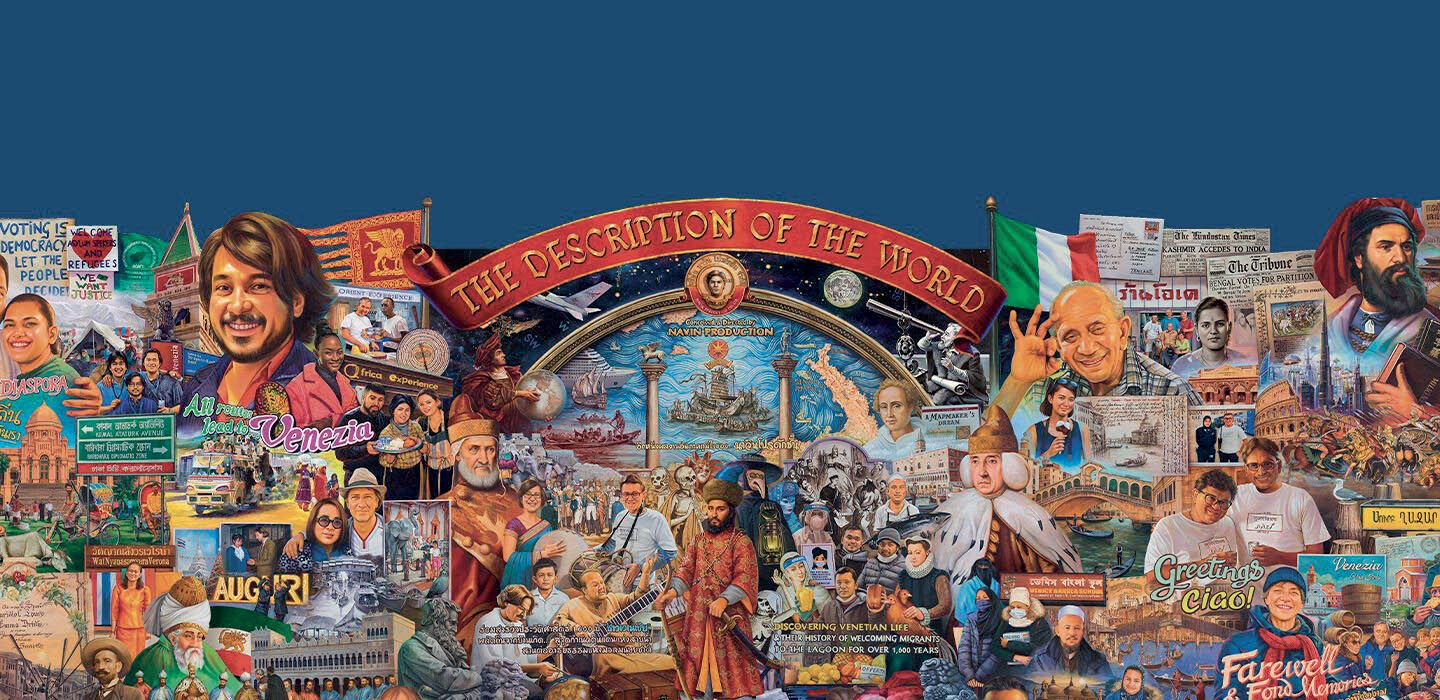

Following Navinland, the project for the Thai National Pavilion in 2011, Navin Rawanchaikul returns to the Biennale Arte with The Description of the World, telling a story that merges Marco Polo and contemporary Venice.
As main sponsor of the 2022 Art Biennale Exhibition, Swatch persent a show of their own to put the focus back on the artists, each encouraged to make new, site-specific works which become part of the main exhibition The Milk of Dreams. The formula is now well established: at Giardini, in an open space in front of the Central Pavilion, a spectacular installation that perfectly captures the spirit of the Swiss brand, a project named The Description of the World, by Thai artist Navin Rawanchaikul. At the Arsenale, in the Sale d’Armi, the collective exhibition Swatch Faces is the result of five residencies at the Swatch Art Peace Hotel in Shanghai.
Describing his project, Navin Rawanchaikul told us that he imagined himself as a novel Marco Polo and, with the idea of ‘community’ in mind, he started a dialogue with the city of Venice laying a thread between East and West that runs through space and time. Blending the Venice of the past with the Venice of today, his story is alive just as his idea of art also is.
Your approach to art is very connected to people and to the local environment. I’m thinking, for example, about the ‘taxi galleries’ (I love Taxi) and about the project of bottles filled with polluted water. How would you describe your art?
I was born in the north of Thailand, which is not a region you would ordinarily associate with the contemporary art scene. I don’t think it bears any direct influence with my art, either. My background is not Thai, actually, but Indian. I am a migrant in Thailand, which means my conception of local culture will be a reflection of that. I tried to integrate my life into this culture, a culture that belongs to people that form the majority in the community I live in. Art is a form of communication with the people around you – that’s the way I see it – rather than with the so-called ‘art system’. I also believe that the starting point of making art is the individual, it is my own experience. It is from there that communication, taking place in the form of art, begins. Connection cannot happen without a plurality of subjects and a given space. We are connected to a local community – always – and the cultural background the artist lives in cannot be discounted. I don’t live in the capital city but in a small town, where I can see the community spirit slowly fading away under the pressure of modernity. This makes me think I can use art, I can use its magic, as a tool to connect with the local spirit and to maybe bring back some of the local creative energy before it’s lost. And I mean right here, in a local context. Again, it is not necessary to inscribe the process of making art in a ‘global art system’ at all.
Connection cannot happen without a plurality of subjects and a given space. We are connected to a local community – always – and the cultural background the artist lives in cannot be discounted.
How did you come to the idea of The Description of the World, your new project for the Swatch exhibition in the upcoming Biennale Arte?
I saw it as a much-needed challenge after a long time being stuck away from my family due to the pandemic. I missed travelling, too, and above all, I missed ‘playing’ with art. While art itself has nothing to do with the pandemic, the pandemic did actually make me reflect on our need for connections, whether with other people out there, individually, or with society as a whole. Art is a positive channel full of possibilities. I felt that the commission to create something for Swatch was not merely about the final product, but about the act, the performance of making art. I flew to Venice and had to quarantine for ten days, which I spent reading. One of the books I read was Marco Polo’s The Description of the World, which everyone knows, and the reason I enjoyed it so much is that I was reading it in Venice! It made me look forward to finally meeting local people after the quarantine. It was a sort of coincidence in reverse: while Marco Polo had travelled eastwards, I was coming to Venice from Asia. And I felt there were other strong connections. Venice is the place where the practice of quarantine originated. Marco Polo was the son of merchants and so am I. Connections beget feelings, and feelings beget creativity and art. So, I decided to write a long letter to Marco Polo. I introduced myself and told him about me, who I am today, a 21st century man from Asia. I told him about my experience in his hometown and I imagined that he would answer me by talking about himself, with details of his personal life, and that he would finally agree to be included in my project, along with other portraits of contemporary Venetians. After the quarantine I was finally able to interact with the city, I took photos and met people, and then brought all this material back to Thailand and reworked it in my studio, together with other artists who through their pictorial art have translated this ideal journey into a visual journey. Human connections are back-and-forth, always. We see it in migrations, too: reasons and conditions of life can be the most diverse, but what never changes is the fact that people are pushed to look for a place to call home and to rebuild their lives, establishing new connections. And in particular for this project, I’m building connections with those who made a similar journey to mine centuries ago.

To what extent is your project put in connection with the Art Biennale, and with Swatch in particular, who have chosen you to represent their identity?
It is of course a great honour for me to be here again. I participated in the 54th Biennale with the Thai Pavilion and my project Navinland – an imaginary world without nations or borders. It is within this broader vision made up of large communities that I recognize my possible contribution to an important and internationally recognized event such as the Biennale. And here is where Swatch also comes into the picture: I was familiar with their products and I own a Swatch watch, but other than that I didn’t really have any ongoing relationship with them. This ‘distance’ and lack of knowledge inspired me and have become a challenge to find common ground through art. Swatch team helped me get in touch with several people who have been very important in building the project. I really appreciated the way Swatch managed to understand exactly what I wanted to accomplish, leaving me total creative freedom. The meaning of our project is an idea of hope, awareness, and openness to as many people as possible. Art must not look only at itself, on the contrary: it works when it is open and not self-important, resulting effectively expressive even in its less pretentious forms, even when it is fun and humorous as in Pop Art. Everything can work, as long as it generates connections. The fact that my installation will be in the open air will also help, I hope, to make it more accessible to a large number of people, to a heterogeneous public such as that of the Biennale. There is and never will be any need to belong to the same culture to enjoy art. Open-mindedness is all it takes.
This little folk story tells us that cultures can mix and live together. It is a dream, right? But sugared milk is something we can actually make, certainly we can in the world of art.
The upcoming Art Biennale is called The Milk of Dreams, which is a title taken from a tiny little book by Leonora Carrington. What is your own milk of dreams?
There’s an Indian story that comes to my mind, although not related to Leonora Carrington’s book. It’s a children’s story about sugar and milk. Once upon a time a group of Persian people were forced to leave their homeland because of religious conflicts. They migrated to Gujarat, in India, and they asked the local king for hospitality. The king showed them a cup full of milk and said: “This is how full my land is, there is plenty of people, no room for more.” So, the Persian chief added some sugar to the king’s milk. The king found it delicious and welcomed the Persian community to live with them. This little folk story tells us that cultures can mix and live together. It is a dream, right? But sugared milk is something we can actually make, certainly we can in the world of art.
Interview with Carlo Giordanetti, Swatch manager and CEO of Swatch Art Peace Hotel